Impact of Land Cover Change Due to Armed Conflicts on Soil Erosion in the Basin of the Northern Al-Kabeer River in Syria Using the RUSLE Model
Abstract
1. Introduction
2. Materials and Methods
2.1. Study Area
2.2. Data
2.3. Soil Erosion Using RUSLE Model
2.4. Role of Vegetation in the Soil Erosion Changes
- -
- The first scenario showed the natural condition of the soil erosion modulus in the initial year in each period of 2009/2010–2013/2014, 2013/2014–2018/2019 and 2009/2010–2018/2019, i.e., the actual soil erosion modulus in each period.
- -
- Scenario C factor fixation is the soil erosion modulus calculated by the C factor value using the end year of each period, i.e., 2013/2014 and 2018/2019, while other factors values remain as used at the initial year of each periods.
3. Results
3.1. Distribution of Soil Erosion Factors in the Northern Al-Kabeer River Basin
3.2. Estimation and Spatial Distribution of Soil Erosion Rates in the Northern Al-Kabeer River Basin
3.3. Impact of Vegetation for Soil Erosion Rates
4. Discussion
5. Conclusions
Funding
Acknowledgments
Conflicts of Interest
Appendix A. Description of RUSLE Model
- Rainfall erosivity factor
- Soil Erodibility Factor (K)
- Slope Length and Steepness Factors (LS)
References
- Diodato, N.; Bellocchi, G. MedREM, a rainfall erosivity model for the Mediterranean region. J. Hydrol. 2010, 387, 119–127. [Google Scholar] [CrossRef]
- Karamesouti, M.; Petropoulos, G.P.; Papanikolaou, I.D.; Kairis, O.; Kosmas, K. Erosion rate predictions from PESERA and RUSLE at a Mediterranean site before and after a wildfire: Comparison & implications. Geoderma 2016, 261, 44–58. [Google Scholar]
- Diodato, N. Estimating RUSLE’s rainfall factor in the part of Italy with a Mediterranean rainfall regime. Hydrol. Earth Syst. Sci. 2004, 8, 103–107. [Google Scholar] [CrossRef]
- Albergel, J.; Collinet, J.; Zante, P.; Hamrouni, H. Role of Mediterranean forest in soil and water conservation. In Water for Forests and People in the Mediterranean Region: A Challenging Balance. What Science Can Tell Us; European Forest Institute: Joensuu, Finland, 2011. [Google Scholar]
- Abdelwahab, O.M.M.; Ricci, G.F.; De Girolamo, A.M.; Gentile, F. Modelling soil erosion in a Mediterranean watershed: Comparison between SWAT and AnnAGNPS models. Environ. Res. 2018, 166, 363–376. [Google Scholar] [CrossRef] [PubMed]
- Polykretis, C.; Alexakis, D.D.; Grillakis, M.G.; Manoudakis, S. Assessment of Intra-Annual and Inter-Annual Variabilities of Soil Erosion in Crete Island (Greece) by Incorporating the Dynamic “Nature” of R and C-Factors in RUSLE Modeling. Remote Sens. 2020, 12, 2439. [Google Scholar] [CrossRef]
- Hategekimana, Y.; Allam, M.; Meng, Q.; Nie, Y.; Mohamed, E. Quantification of soil losses along the coastal protected areas in Kenya. Land 2020, 9, 137. [Google Scholar] [CrossRef]
- Woldemariam, G.; Iguala, A.; Tekalign, S.; Reddy, R. Spatial Modeling of Soil Erosion Risk and Its Implication for Conservation Planning: The Case of the Gobele Watershed, East Hararghe Zone, Ethiopia. Land 2018, 7, 25. [Google Scholar] [CrossRef]
- Eisenberg, J.; Muvundja, F.A. Quantification of Erosion in Selected Catchment Areas of the Ruzizi River (DRC) Using the (R)USLE Model. Land 2020, 9, 125. [Google Scholar] [CrossRef]
- Food and Agricultural Organization (FAO). Soil Erosion; FAO: Rome, Italy, 2019. [Google Scholar]
- Food and Agricultural Organization (FAO). Forests and Climate Change in the Near East Region; Forests and Climate Change Working Papers 9; FAO: Rome, Italy, 2010. [Google Scholar]
- Habib, L.; Ibrahim, W. STATUS OF SOIL RESOURCE IN SYRIA. In Proceedings of the Assessment of Existing Soil Information System, Damascus, 2007, Tunis, Tunisia, 26–31 May 2007. [Google Scholar]
- Mohammed, S.A.; Alkerdi, A.; Nagy, J.; Harsányi, E. Syrian crisis repercussions on the agricultural sector: Case study of wheat, cotton and olives. Reg. Sci. Policy Pract. 2020, 12, 519–537. [Google Scholar] [CrossRef]
- Selby, J.; Dahi, O.S.; Fröhlich, C.; Hulme, M. Climate change and the Syrian civil war revisited. Political Geogr. 2017, 60, 232–244. [Google Scholar] [CrossRef]
- Global Forest Watch Syria. Available online: https://www.globalforestwatch.org/dashboards/country/SYR/ (accessed on 7 June 2020).
- Nackoney, J.; Molinario, G.; Potapov, P.; Turubanova, S.; Hansen, M.C.; Furuichi, T. Impacts of civil conflict on primary forest habitat in northern Democratic Republic of the Congo, 1990–2010. Biol. Conserv. 2014, 170, 321–328. [Google Scholar] [CrossRef]
- Ordway, E.M. Political shifts and changing forests: Effects of armed conflict on forest conservation in Rwanda. Glob. Ecol. Conserv. 2015, 3, 448–460. [Google Scholar] [CrossRef]
- Machlis, G.E.; Hanson, T. Warfare Ecology. NATO Sci. Peace Secur. Ser. C Environ. Secur. 2011, 113, 33–40. [Google Scholar]
- Kim, K.C. Preserving biodiversity in Korea’s demilitarized zone. Science 1997, 278, 242–243. [Google Scholar] [CrossRef]
- Baumann, M.; Kuemmerle, T. The impacts of warfare and armed conflict on land systems. J. Land Use Sci. 2016, 11, 672–688. [Google Scholar] [CrossRef]
- Hecht, S.B.; Saatchi, S.S. Globalization and Forest Resurgence: Changes in Forest Cover in El Salvador. Bioscience 2007, 57, 663–672. [Google Scholar] [CrossRef]
- Al-Ali, Y.; Shater, Z.; Kheder, R. Studying the Effect of Forest Fire on Soil Erosion and Loss of Some Mineral Elements in the Forest of Ein Al-Jaouz/Tartous. Tishreen Univ. J. Res. Sci. Stud. Biol. Sci. Ser. 2014, 36, 277–290. [Google Scholar]
- Kabibo, I.A.-D.; Bou-Issa, A.; Ibrahim, J. Studying the Effect of Soil Erosion for Eight Different Systems with Different Slopes in the Coastal Area under Forests, Burned Forest and Planted Soil System. Tishreen Univ. J. Res. Sci. Stud. Biol. Sci. Ser. 2017, 1, 25–38. [Google Scholar]
- Mohammed, S.; Abdo, H.G.; Szabo, S.; Pham, Q.B.; Holb, I.J.; Linh, N.T.T.; Anh, D.T.; Alsafadi, K.; Mokhtar, A.; Kbibo, I.; et al. Estimating Human Impacts on Soil Erosion Considering Different Hillslope Inclinations and Land Uses in the Coastal Region of Syria. Water 2020, 12, 2786. [Google Scholar] [CrossRef]
- Mohammed, S.; Alsafadi, K.; Talukdar, S.; Kiwan, S.; Hennawi, S.; Alshihabi, O.; Sharaf, M.; Harsanyie, E. Estimation of soil erosion risk in southern part of Syria by using RUSLE integrating geo informatics approach. Remote Sens. Appl. Soc. Environ. 2020, 20, 100375. [Google Scholar] [CrossRef]
- Almohamad, H.; Knaack, A.L.; Habib, B.M. Assessing Spatial Equity and Accessibility of Public Green Spaces in Aleppo City, Syria. Forests 2018, 9, 706. [Google Scholar] [CrossRef]
- Almohamad, H.; Dittmann, A. Oil in Syria between Terrorism and Dictatorship. Soc. Sci. 2016, 5, 20. [Google Scholar] [CrossRef]
- Renard, B.K.G.; Foster, G.R.; Weesies, G.A.; Porter, J.I. Revised universal soil loss equation (Rusle). J. Soil Water Conserv. 1991, 46, 30–33. [Google Scholar]
- Marti, N.; Goci, M. Changes in Soil Erosion Intensity Caused by Land Use and Demographic Changes in the Jablanica River Basin, Serbia. Agriculture 2020, 10, 345. [Google Scholar]
- Licciardello, F.; Govers, G.; Cerdan, O.; Kirkby, M.J.; Vacca, A.; Kwaad, F.J.P.M. Evaluation of the PESERA model in two contrasting environments. Earth Surf. Process. Landf. 2009, 34, 629–640. [Google Scholar] [CrossRef]
- Kirkby, M.J.; Irvine, B.J.; Jones, R.J.A.; Govers, G.; Boer, M.; Cerdan, O.; Daroussin, J.; Gobin, A.; Grimm, M.; Le Bissonnais, Y.; et al. The PESERA coarse scale erosion model for Europe. I.—Model rationale and implementation. Eur. J. Soil Sci. 2008, 59, 1293–1306. [Google Scholar] [CrossRef]
- Baigorria, G.A.; Romero, C.C. Assessment of erosion hotspots in a watershed: Integrating the WEPP model and GIS in a case study in the Peruvian Andes. Environ. Model. Softw. 2007, 22, 1175–1183. [Google Scholar] [CrossRef]
- Laflen, J.M.; Lane, L.J.; Foster, G. WEPP: A new generation of erosion prediction technology. J. Soil Water Conserv. 1991, 46, 34–38. [Google Scholar]
- Gyssels, G.; Poesen, J.; Bochet, E.; Li, Y. Impact of plant roots on the resistance of soils to erosion by water: A review. Prog. Phys. Geogr. 2005, 29, 189–217. [Google Scholar] [CrossRef]
- Arabameri, A.; Cerda, A.; Tiefenbacher, J.P. Spatial pattern analysis and prediction of gully erosion using novel hybrid model of entropy-weight of evidence. Water 2019, 11, 1129. [Google Scholar] [CrossRef]
- Angulo-Martínez, M.; Beguería, S. Estimating rainfall erosivity from daily precipitation records: A comparison among methods using data from the Ebro Basin (NE Spain). J. Hydrol. 2009, 379, 111–121. [Google Scholar] [CrossRef]
- Farhan, Y.; Zregat, D.; Farhan, I. Spatial Estimation of Soil Erosion Risk Using RUSLE Approach, RS, and GIS Techniques: A Case Study of Kufranja Watershed, Northern Jordan. J. Water Resour. Prot. 2013, 5, 1247–1261. [Google Scholar] [CrossRef]
- Alkharabsheh, M.M.; Alexandridis, T.K.; Bilas, G.; Misopolinos, N.; Silleos, N. Impact of Land Cover Change on Soil Erosion Hazard in Northern Jordan Using Remote Sensing and GIS. Procedia Environ. Sci. 2013, 19, 912–921. [Google Scholar] [CrossRef]
- Vinson, J.A.; Barrett, S.M.; Aust, W.M.; Bolding, M.C. Suitability of soil erosion models for the evaluation of bladed skid trail BMPs in the Southern appalachians. Forests 2017, 8, 482. [Google Scholar] [CrossRef]
- Uddin, K.; Matin, M.A.; Maharjan, S. Assessment of land cover change and its impact on changes in soil erosion risk in Nepal. Sustainability 2018, 10, 4715. [Google Scholar] [CrossRef]
- Das, T. Estimation of Annual Average Soil Loss and Preparation of Spatially Distributed Soil Loss Map: A Case Study of Dhansiri River Basin; Indian Institute of Technology Guwahati: Guwahati, India, 2017; p. 38. [Google Scholar]
- Ferreira, V.; Panagopoulos, T. Seasonality of soil erosion under Mediterranean conditions at the Alqueva dam watershed. Environ. Manag. 2014, 54, 67–83. [Google Scholar] [CrossRef] [PubMed]
- Alewell, C.; Borrelli, P.; Meusburger, K.; Panagos, P. Using the USLE: Chances, challenges and limitations of soil erosion modelling. Int. Soil Water Conserv. Res. 2019, 7, 203–225. [Google Scholar] [CrossRef]
- Abu Hammad, A.; Lundekvam, H.; Børresen, T. Adaptation of RUSLE in the eastern part of the Mediterranean region. Environ. Manag. 2004, 34, 829–841. [Google Scholar] [CrossRef]
- Aiello, A.; Adamo, M.; Canora, F. Remote sensing and GIS to assess soil erosion with RUSLE3D and USPED at river basin scale in southern Italy. Catena 2015, 131, 174–185. [Google Scholar] [CrossRef]
- Hasan, I.A.; Hammad, M.; Ahmad, M.; Boubou, M.; Yazaji, Z. Studying of Sedimentation in Reservoir of 16 November Dam. Tishreen Univ. J. Res. Sci. Stud. Eng. Sci. Ser. 2019, 41, 23–43. [Google Scholar]
- Niu, L.; Shao, Q. Soil conservation service spatiotemporal variability and its driving mechanism on the Guizhou Plateau, China. Remote Sens. 2020, 12, 2187. [Google Scholar] [CrossRef]
- Aslam, B.; Maqsoom, A.; Shahzaib; Kazmi, Z.A.; Sodangi, M.; Anwar, F.; Bakri, M.H.; Faisal Tufail, R.; Farooq, D. Effects of Landscape Changes on Soil Erosion in the Built Environment: Application of Geospatial-Based RUSLE Technique. Sustainability 2020, 12, 5898. [Google Scholar] [CrossRef]
- Barakat, M.; Mahfoud, I.; Kwyes, A.A. Study of soil erosion risk in the basin of Northern Al-Kabeer river at Lattakia-Syria using remote sensing and GIS techniques. Mesop. J. 2014, 29, 29–44. [Google Scholar]
- Ghazal, A. Landscape Ecological, Phytosociological and Geobotanical Study of Eu-Mediterranean in West of Syria; University of Hohenheim: Stuttgart, Germany, 2008. [Google Scholar]
- Renard, K.G.; Foster, G.R.; Weesies, G.A.; McCool, D.K.; Yoder, D.C. Predicting Soil Erosion by Water: A Guide to Conservation Planning with the Revised Universal Soil Loss Equation (RUSLE); United States Government Printing: Washington, DC, USA, 1997.
- Biswas, S.S.; Pani, P. Estimation of soil erosion using RUSLE and GIS techniques: A case study of Barakar River basin, Jharkhand, India. Model. Earth Syst. Environ. 2015, 1, 42. [Google Scholar] [CrossRef]
- Karamage, F.; Shao, H.; Chen, X.; Ndayisaba, F.; Nahayo, L.; Kayiranga, A.; Omifolaji, J.K.; Liu, T.; Zhang, C. Deforestation effects on soil erosion in the Lake Kivu Basin, D.R. Congo-Rwanda. Forests 2016, 7, 281. [Google Scholar] [CrossRef]
- Koirala, P.; Thakuri, S.; Joshi, S.; Chauhan, R. Estimation of Soil Erosion in Nepal using a RUSLE modeling and geospatial tool. Geosciences 2019, 9, 147. [Google Scholar] [CrossRef]
- Barakat, M.; Ileen Mahfood, A.A.A.-K. Study of the soil water erosion in the basin of 16 Tishreen Dam in the province of Lattakia using Geographic Information System techniques (GIS). Tishreen Univ. J. Res. Sci. Stud. 2013, 35, 85–104. [Google Scholar]
- Sabri, E.; Boukdir, A.; Mabrouki, M.; Romaric, V.; Mbaki, E. Predicting Soil Erosion and Sediment Yield in Oued El Abid Watershed, Morocco; ATINER’s Conference Paper Series GEO2016–2091; Athens Institute for Education and Research ATINER: Athens, Greece, 2016; p. 23. [Google Scholar]
- Yavuz, M.; Tufekcioglu, M. Estimating Surface Soil Losses in the Mountainous Semi-Arid Watershed using RUSLE and Geospatial Technologies. Fresenius Environ. Bull. 2019, 28, 2589–2598. [Google Scholar]
- Irvem, A.; Topaloǧlu, F.; Uygur, V. Estimating spatial distribution of soil loss over Seyhan River Basin in Turkey. J. Hydrol. 2007, 336, 30–37. [Google Scholar] [CrossRef]
- Sharpley, A.N.; Williams, J.R. EPIC: The erosion-productivity impact calculator. U.S. Dep. Agric. Tech. Bull. 1990, 1768, 235. [Google Scholar]
- Desmet, P.J.J.; Govers, G. A GIS procedure for automatically calculating the USLE LS factor on topographically complex landscape units. J. Soil Water Conserv. 1996, 51, 427–433. [Google Scholar]
- Van der Knijff, J.M.F.; Jones, R.J.A.; Montanarella, L. Soil Erosion Risk Assessment Italy; European Soil Bureau, European Commission: Brussels, Belgium, 1999. [Google Scholar]
- Wang, Z.; Su, Y. Assessment of Soil Erosion in the Qinba Mountains of the Southern Shaanxi Province in China Using the RUSLE Model. Sustainability 2020, 12, 1733. [Google Scholar] [CrossRef]
- Panagos, P.; Borrelli, P.; Poesen, J.; Ballabio, C.; Lugato, E.; Meusburger, K.; Montanarella, L.; Alewell, C. The new assessment of soil loss by water erosion in Europe. Environ. Sci. Policy 2015, 54, 438–447. [Google Scholar] [CrossRef]
- Poesen, J.W.A.; Hooke, J.M. Erosion, flooding and channel management in Mediterranean environments of southern Europe. Prog. Phys. Geogr. 1997, 21, 157–199. [Google Scholar] [CrossRef]
- García-Ruiz, J.M.; Nadal-Romero, E.; Lana-Renault, N.; Beguería, S. Erosion in Mediterranean landscapes: Changes and future challenges. Geomorphology 2013, 198, 20–36. [Google Scholar] [CrossRef]
- Panagos, P.; Borrelli, P.; Meusburger, K. A new European slope length and steepness factor (LS-factor) for modeling soil erosion by water. Geosciences 2015, 5, 117–126. [Google Scholar] [CrossRef]
- Mousa, F.H.; Sarhan Laykah, M.A. Studying the Effect of Fire on Regeneration of Natural Vegetation in Kassab. Damascus Univ. J. Basic Sci. 2011, 27, 115–136. [Google Scholar]
- Jaafar, H.H.; Zurayk, R.; King, C.; Ahmad, F.; Al-Outa, R. Impact of the Syrian conflict on irrigated agriculture in the Orontes Basin. Int. J. Water Resour. Dev. 2015, 31, 436–449. [Google Scholar] [CrossRef]
- Juerges, N.; Hansjürgens, B. Soil governance in the transition towards a sustainable bioeconomy—A review. J. Clean. Prod. 2018, 170, 1628–1639. [Google Scholar] [CrossRef]
- Shiferaw, B.A.; Okello, J.; Reddy, R.V. Adoption and adaptation of natural resource management innovations in smallholder agriculture: Reflections on key lessons and best practices. Environ. Dev. Sustain. 2009, 11, 601–619. [Google Scholar] [CrossRef]
- Stocking, M.A. Tropical Soils and Food Security: The Next 50 Years. Science 2003, 302, 1356–1359. [Google Scholar] [CrossRef] [PubMed]
- Raclot, D.; Le Bissonnais, Y.; Annabi, M.; Sabir, M.; Smetanova, A. Main Issues for Preserving Mediterranean Soil Resources From Water Erosion Under Global Change. Land Degrad. Dev. 2018, 29, 789–799. [Google Scholar] [CrossRef]
- Hui, L.; Xiaoling, C.; Lim, K.J.; Xiaobin, C.; Sagong, M. Assessment of soil erosion and sediment yield in Liao watershed, Jiangxi Province, China, Using USLE, GIS, and RS. J. Earth Sci. 2010, 21, 941–953. [Google Scholar] [CrossRef]
- Arnoldus, H.M.J. Methodology Used to Determine the Maximum Potential Range Average Annual Soil Loss to Sheet and Rill Erosion in Morocco. Assessing Soil Degradation. FAO Soils Bull. 1977, 34, 39–48. [Google Scholar]
- Renard, K.G.; Freimund, J.R. Using monthly precipitation data to estimate the R-factor in the revised USLE. J. Hydrol. 1994, 157, 287–306. [Google Scholar] [CrossRef]
- Oliveira, J.A.; Dominguez, J.M.L.; Nearing, M.A.; Oliveira, P.T.S. A GIS-Based procedure for automatically calculating soil loss from the universal soil loss Equation: GISus-M. Appl. Eng. Agric. 2015, 31, 907–917. [Google Scholar]

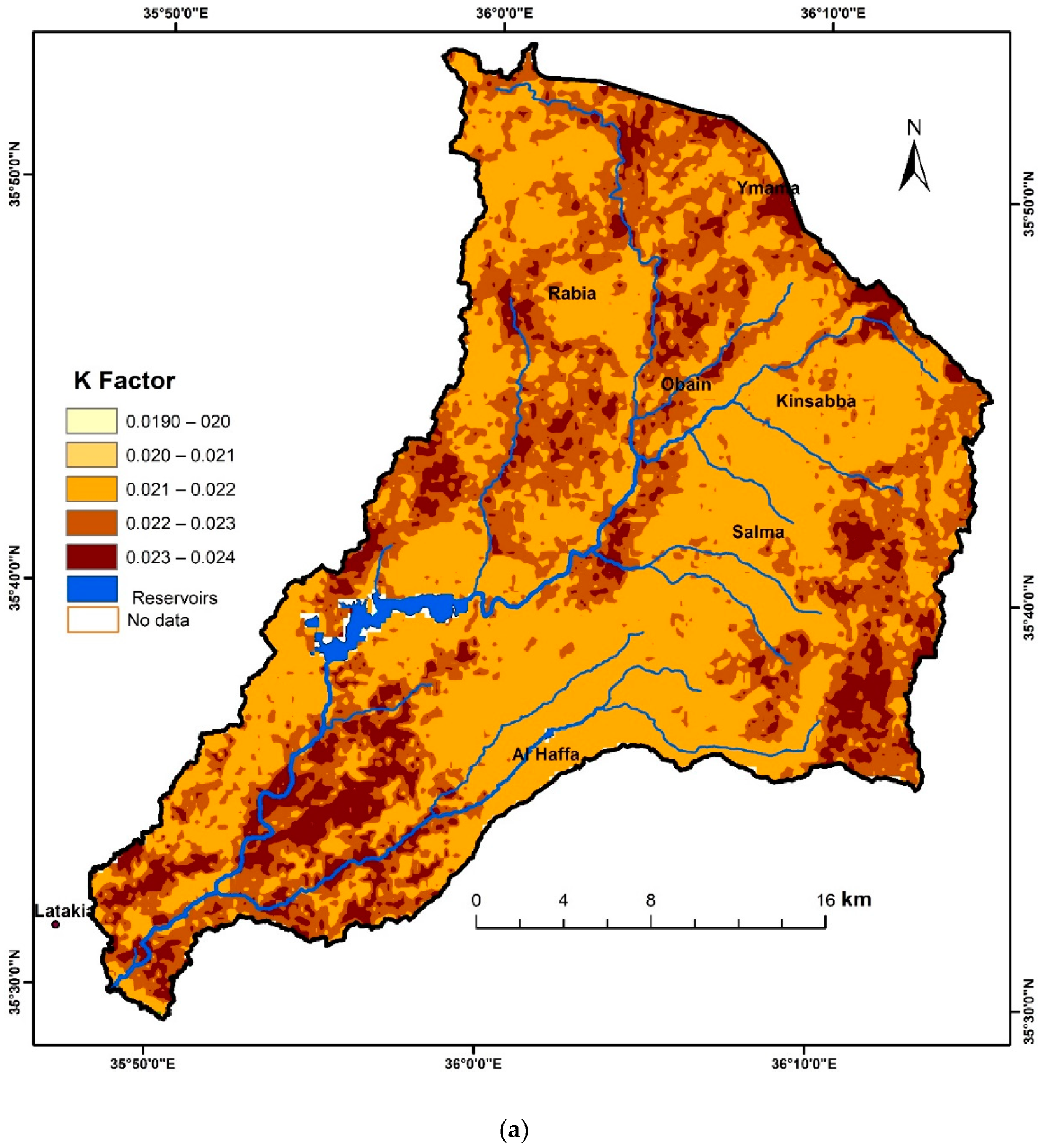
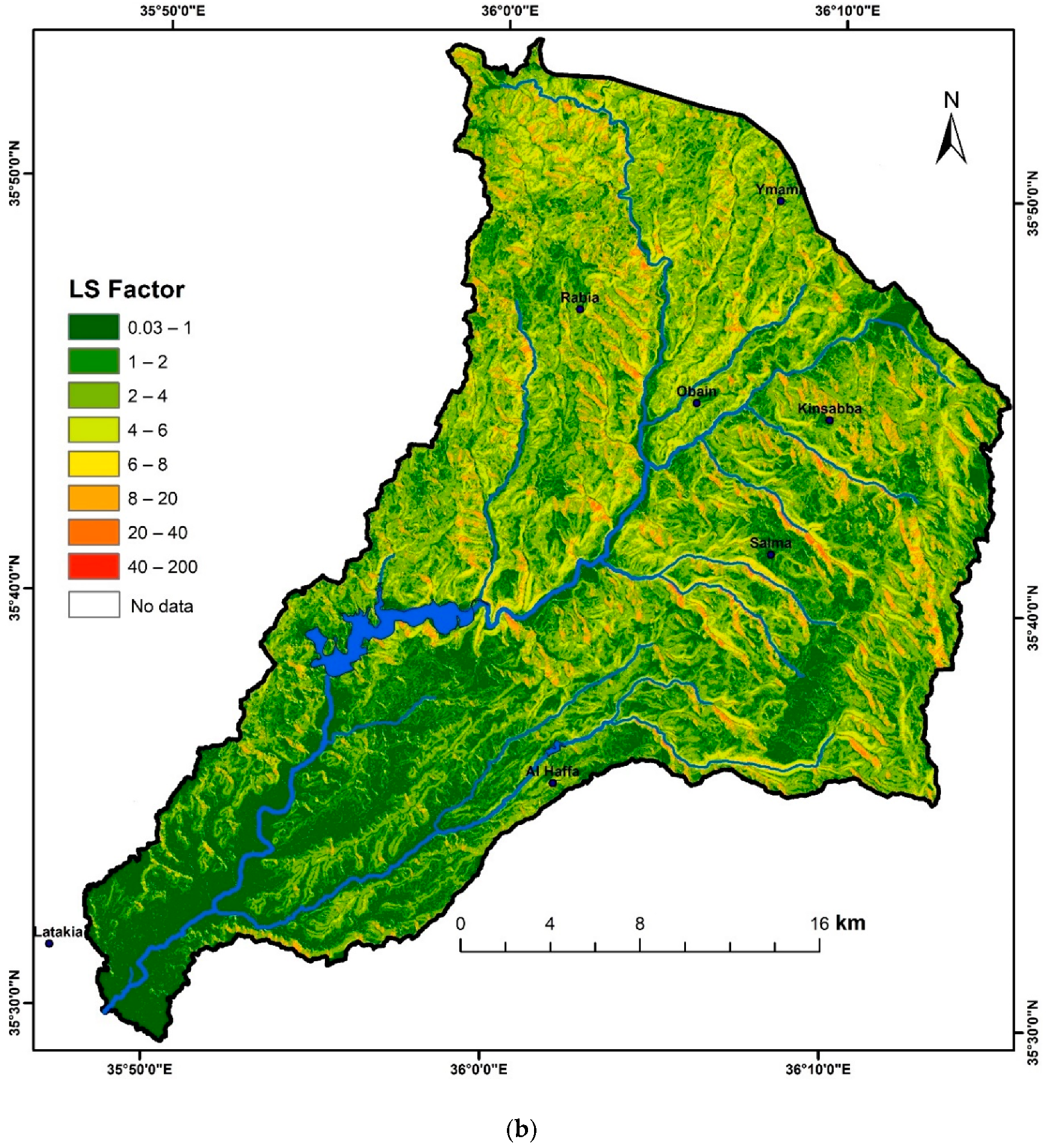

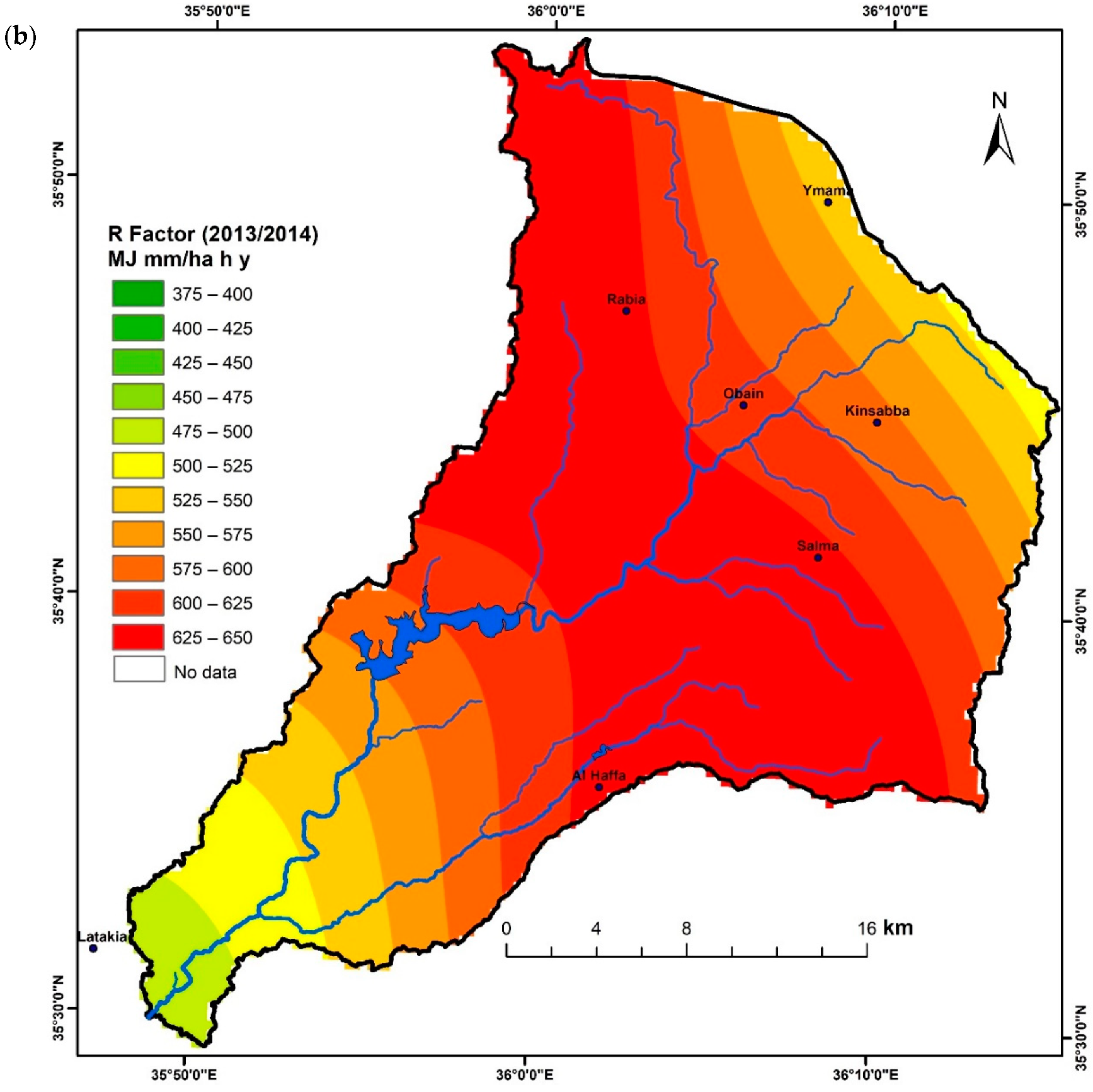
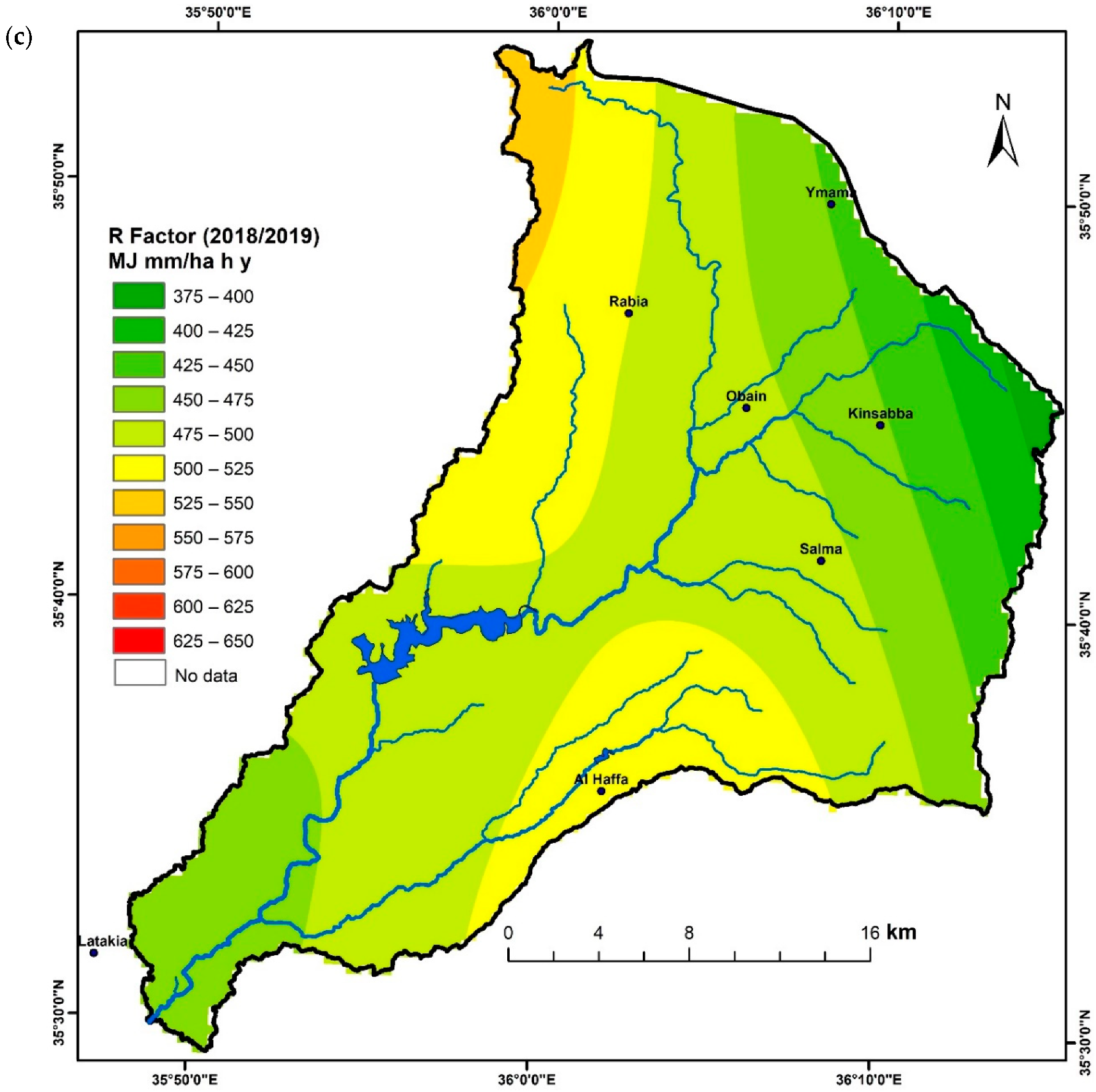


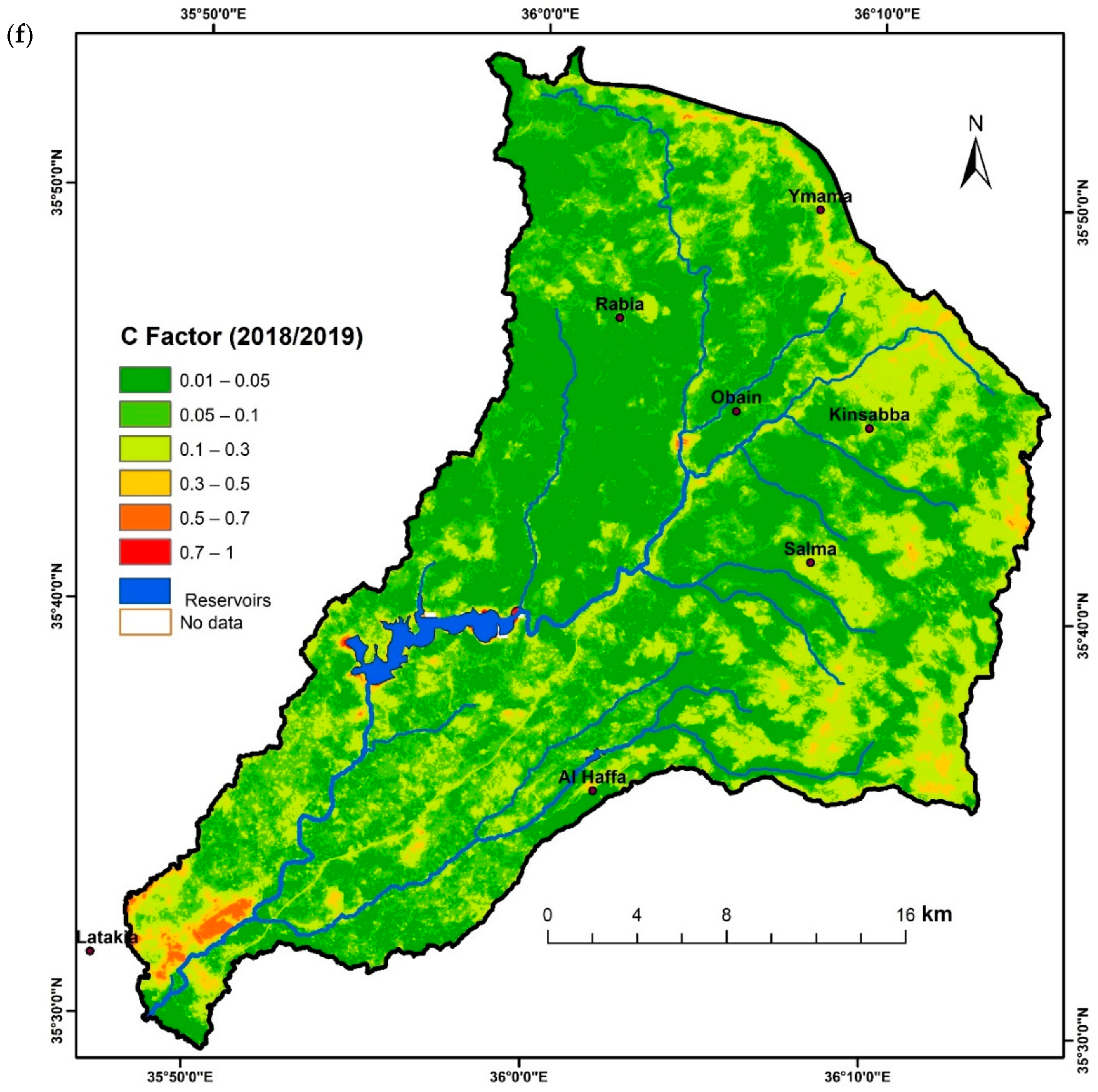

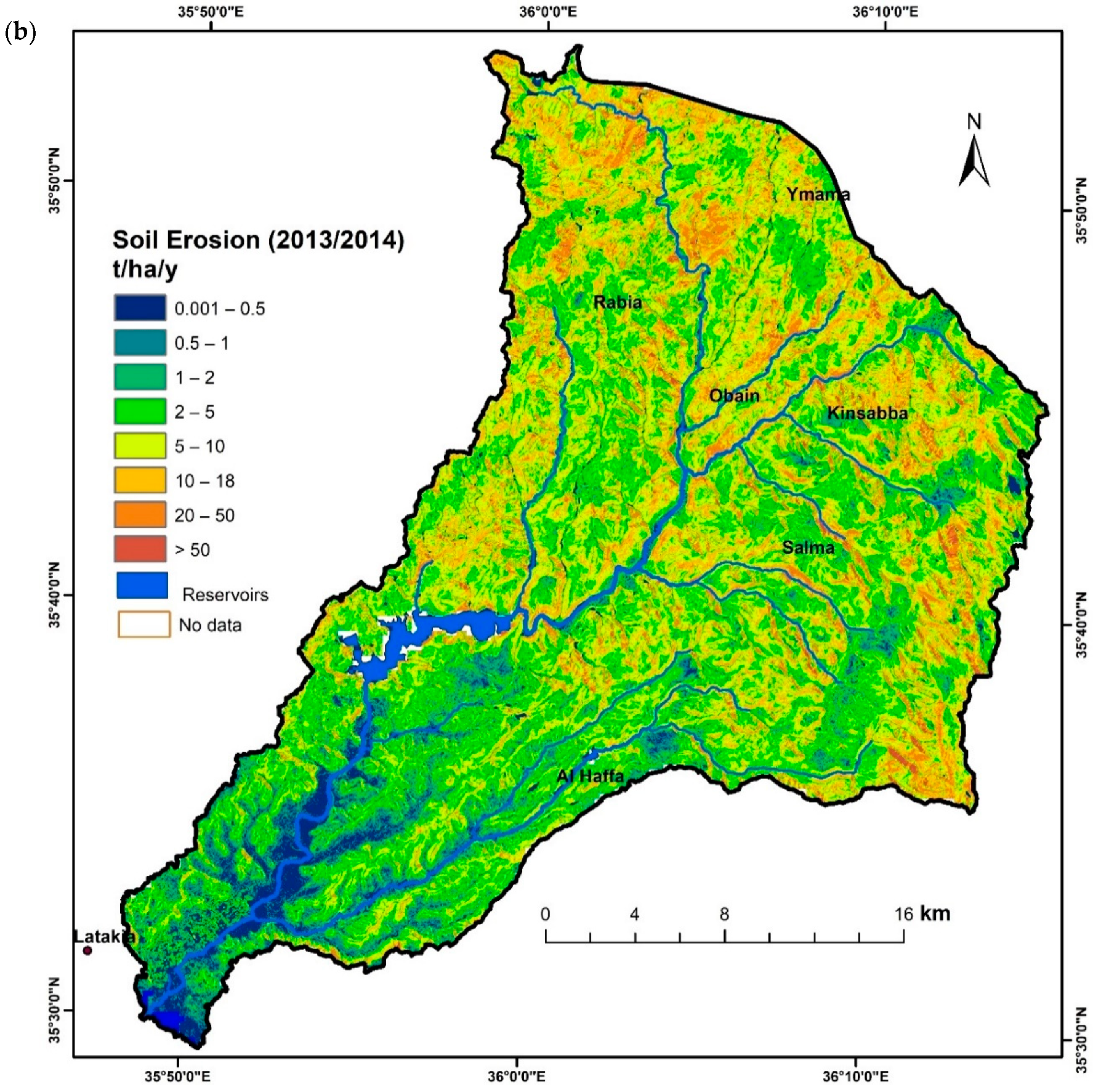
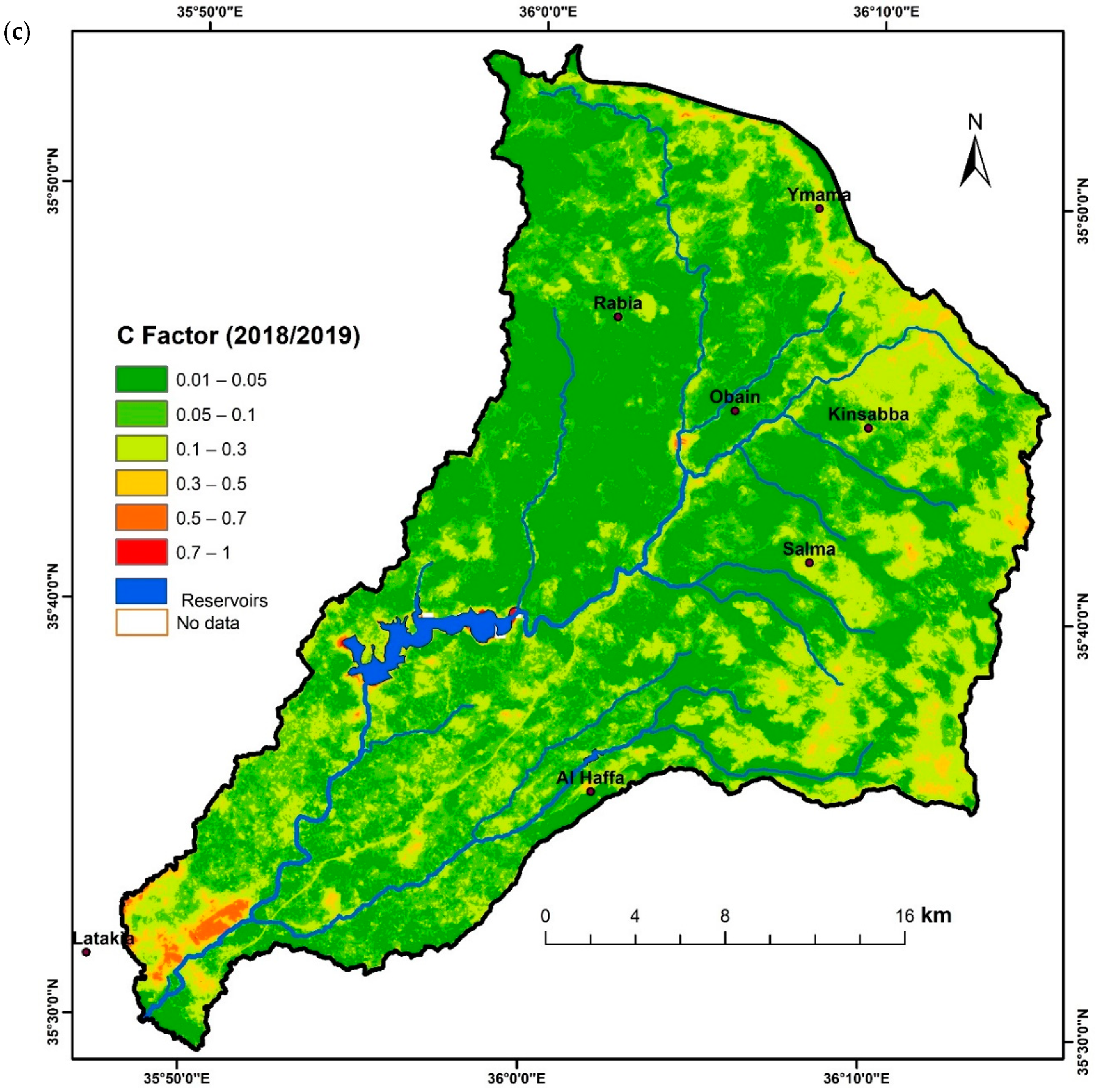
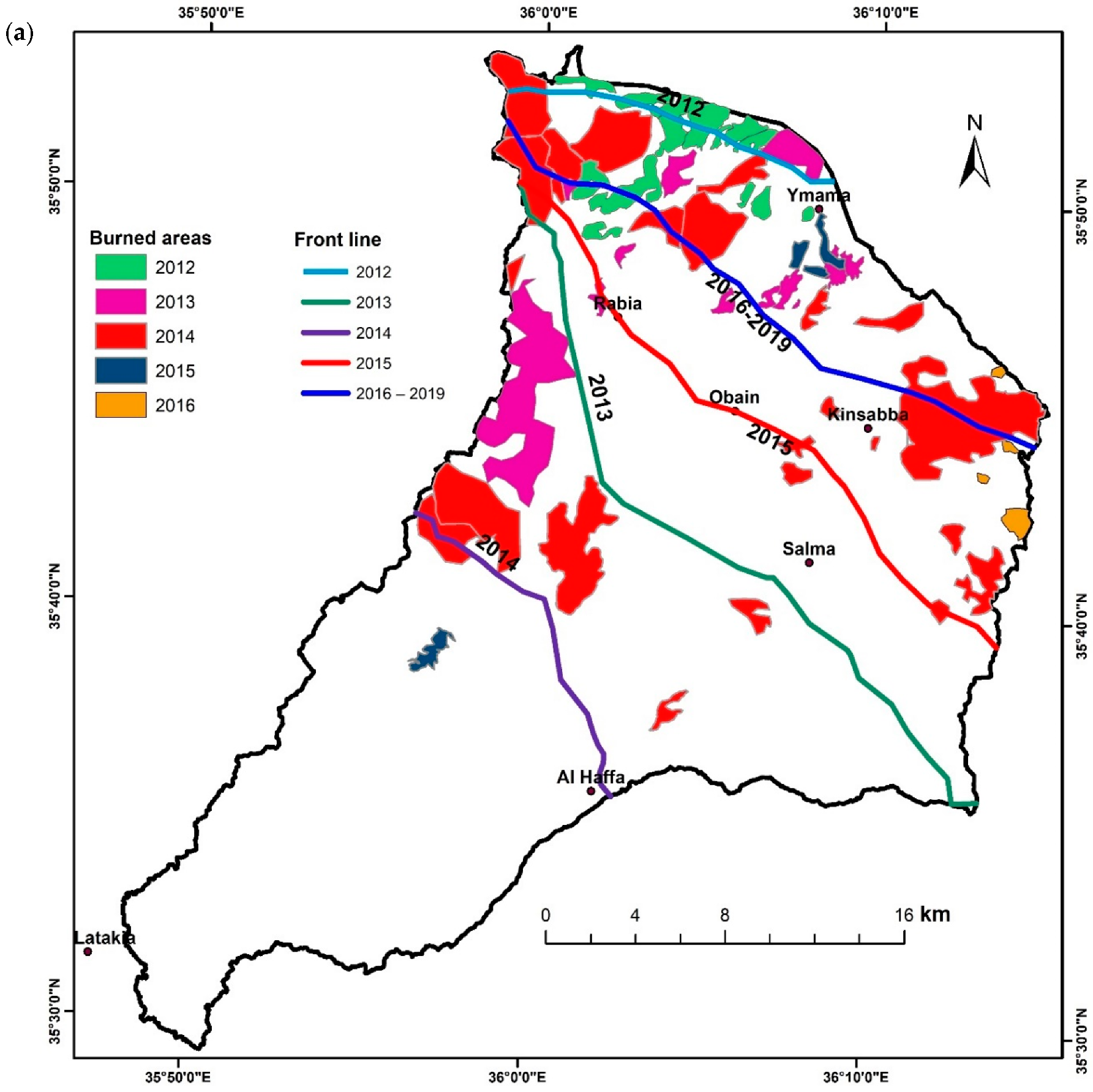

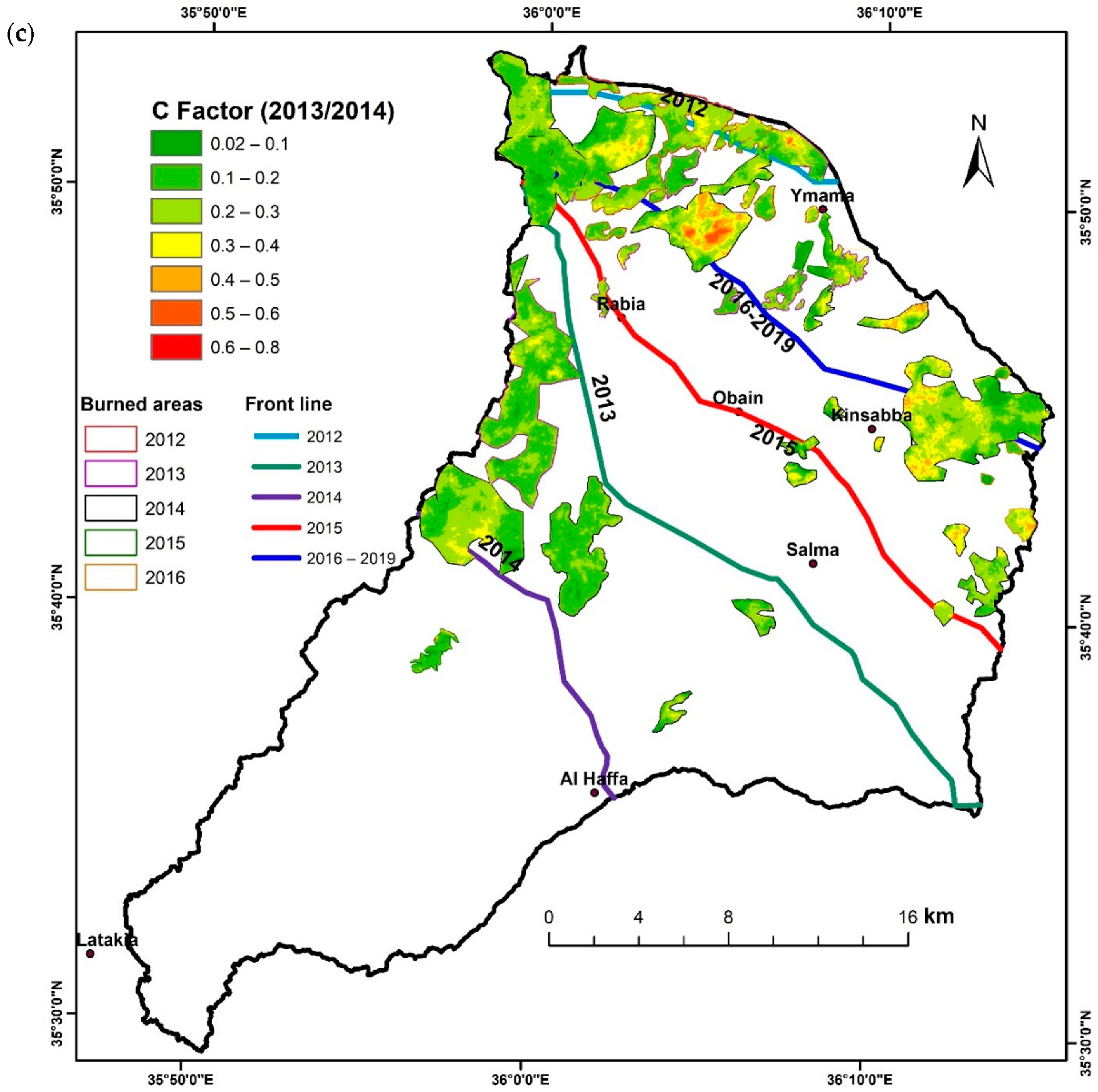
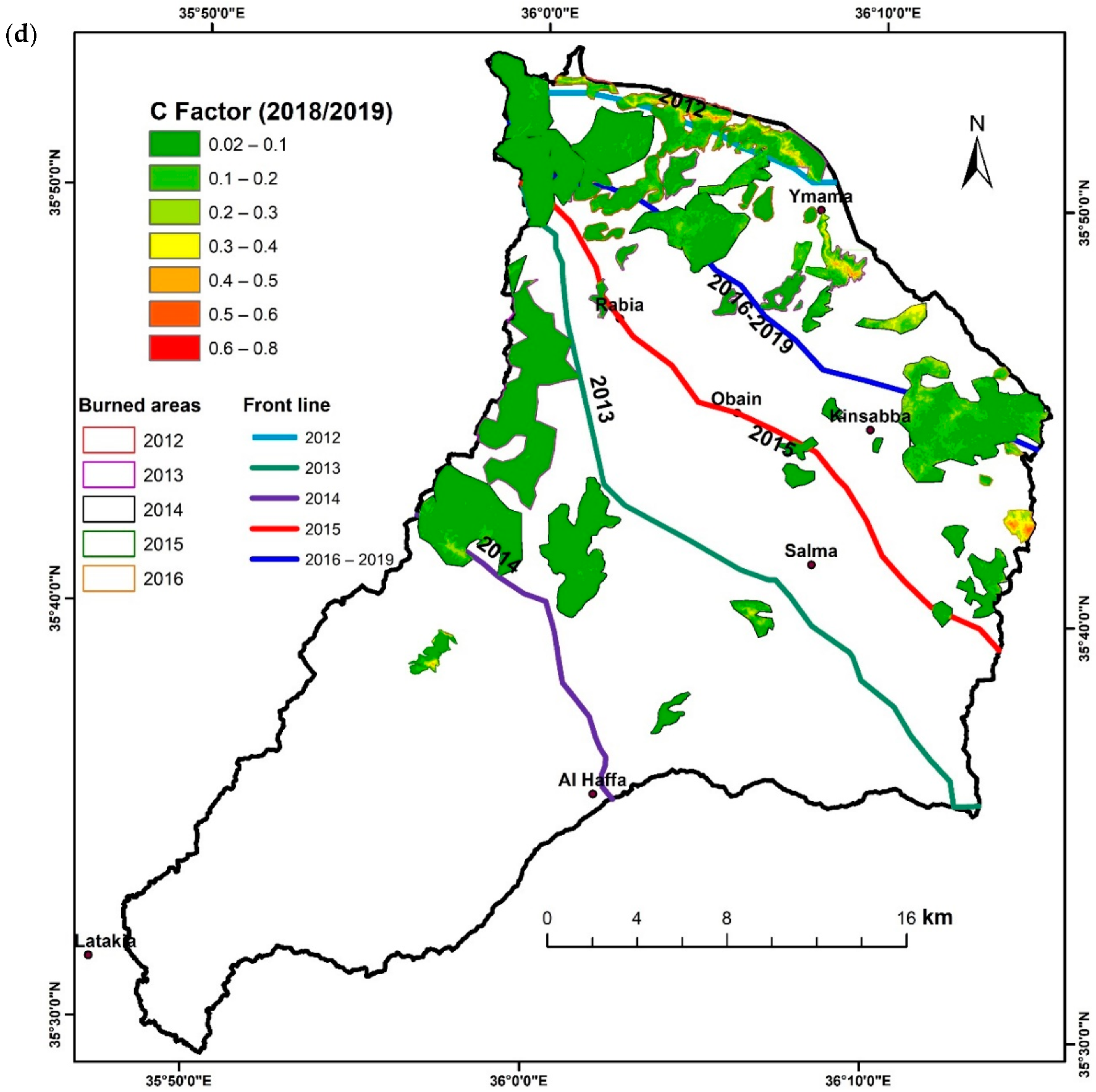
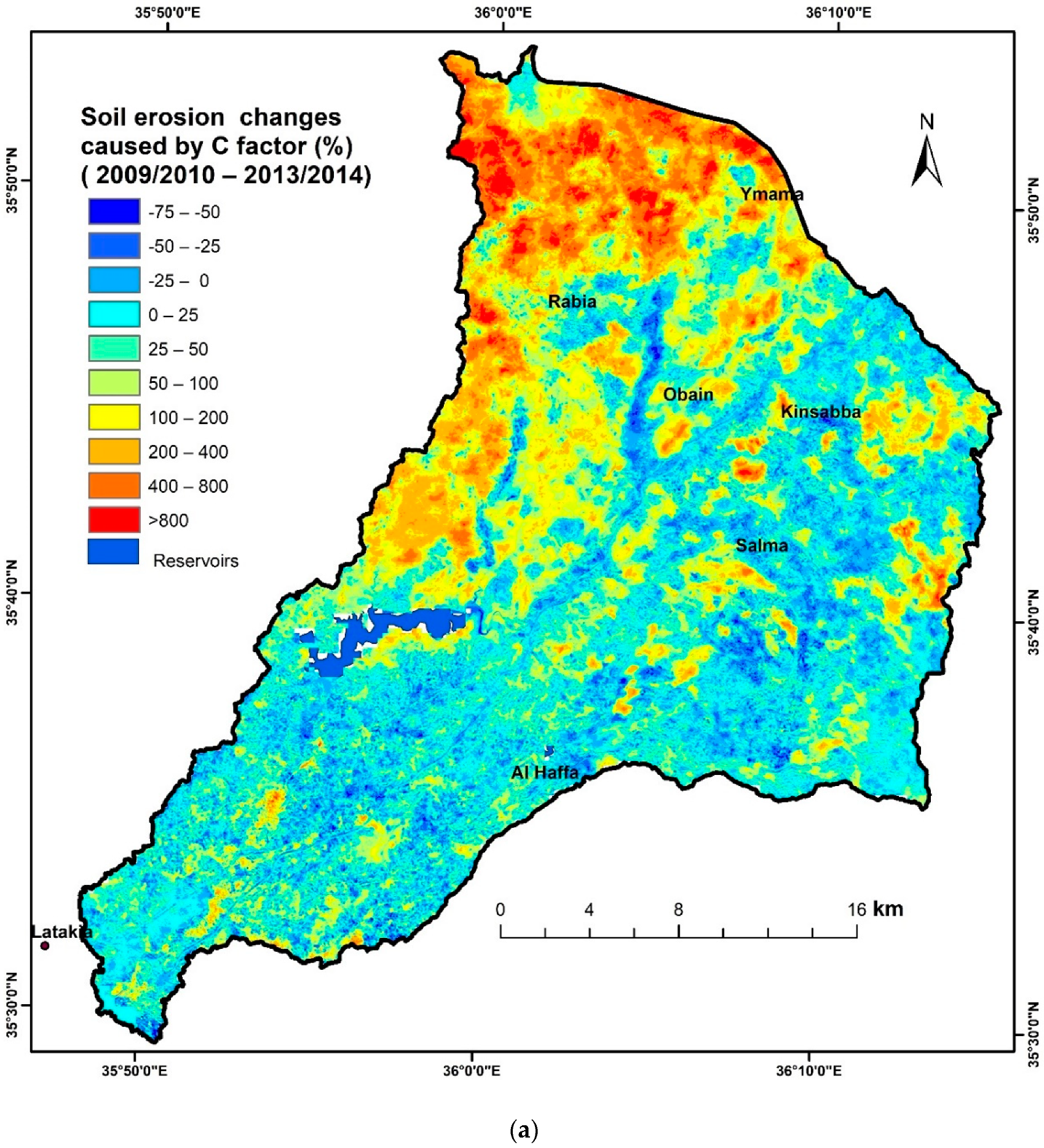
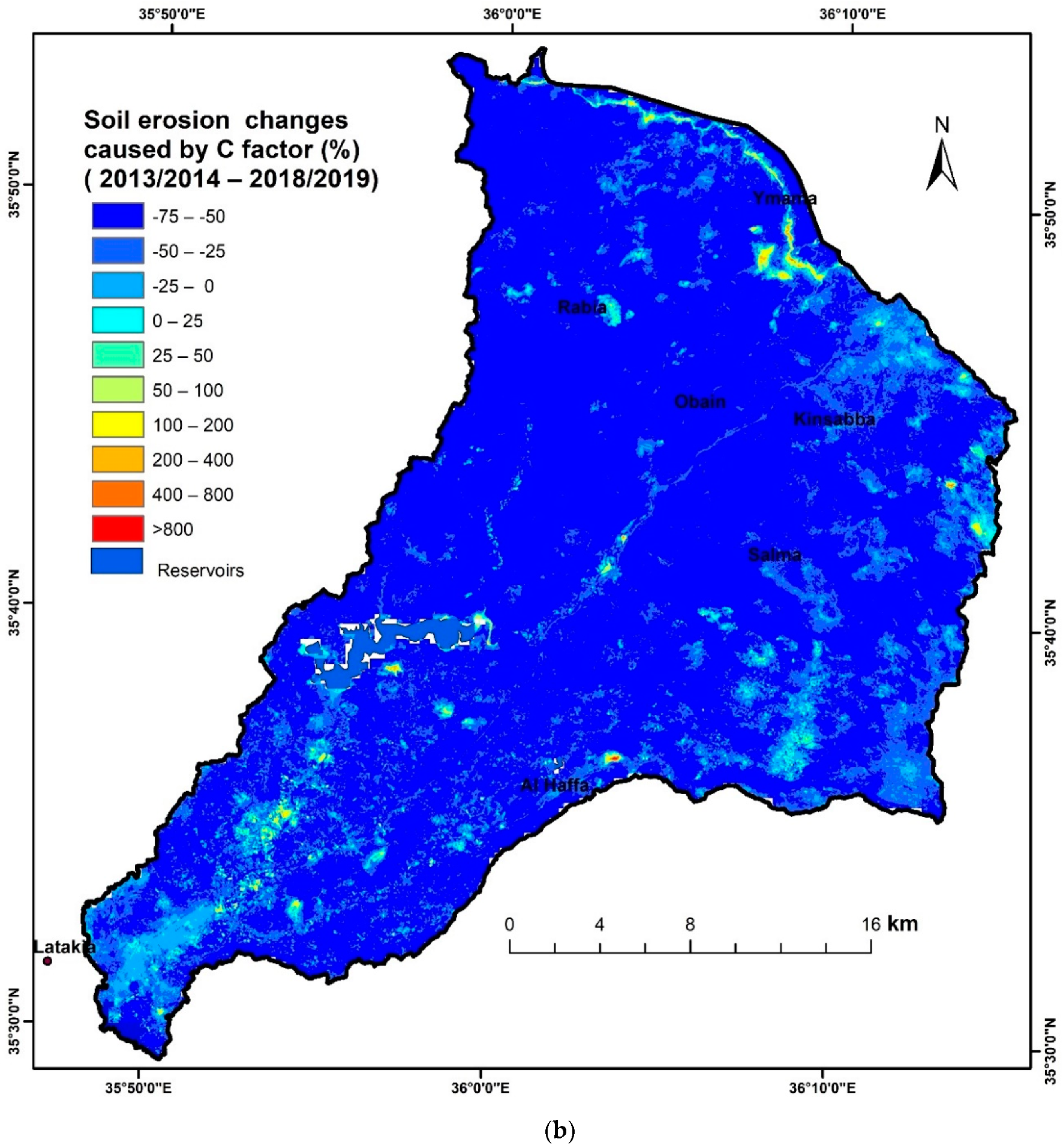

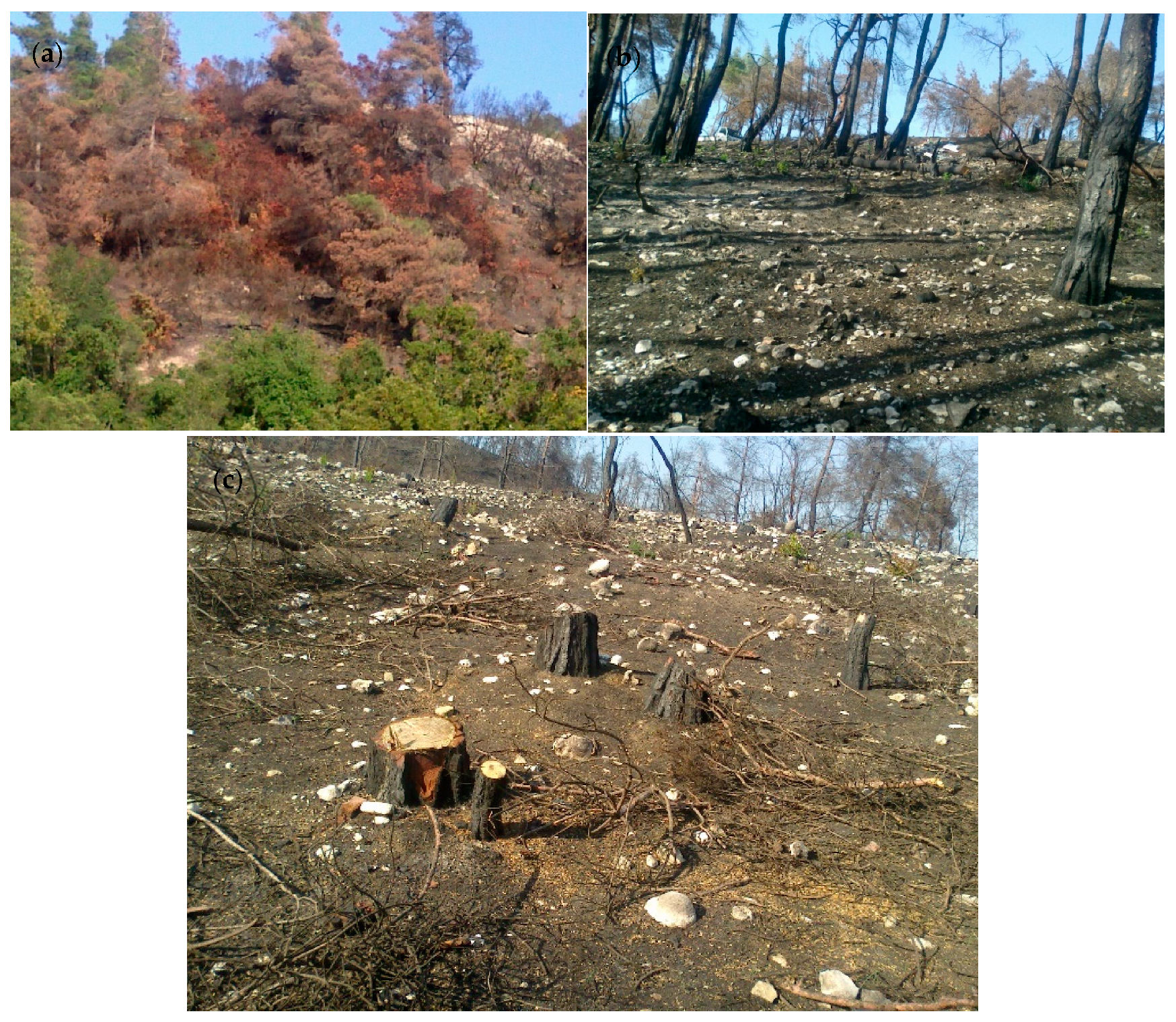
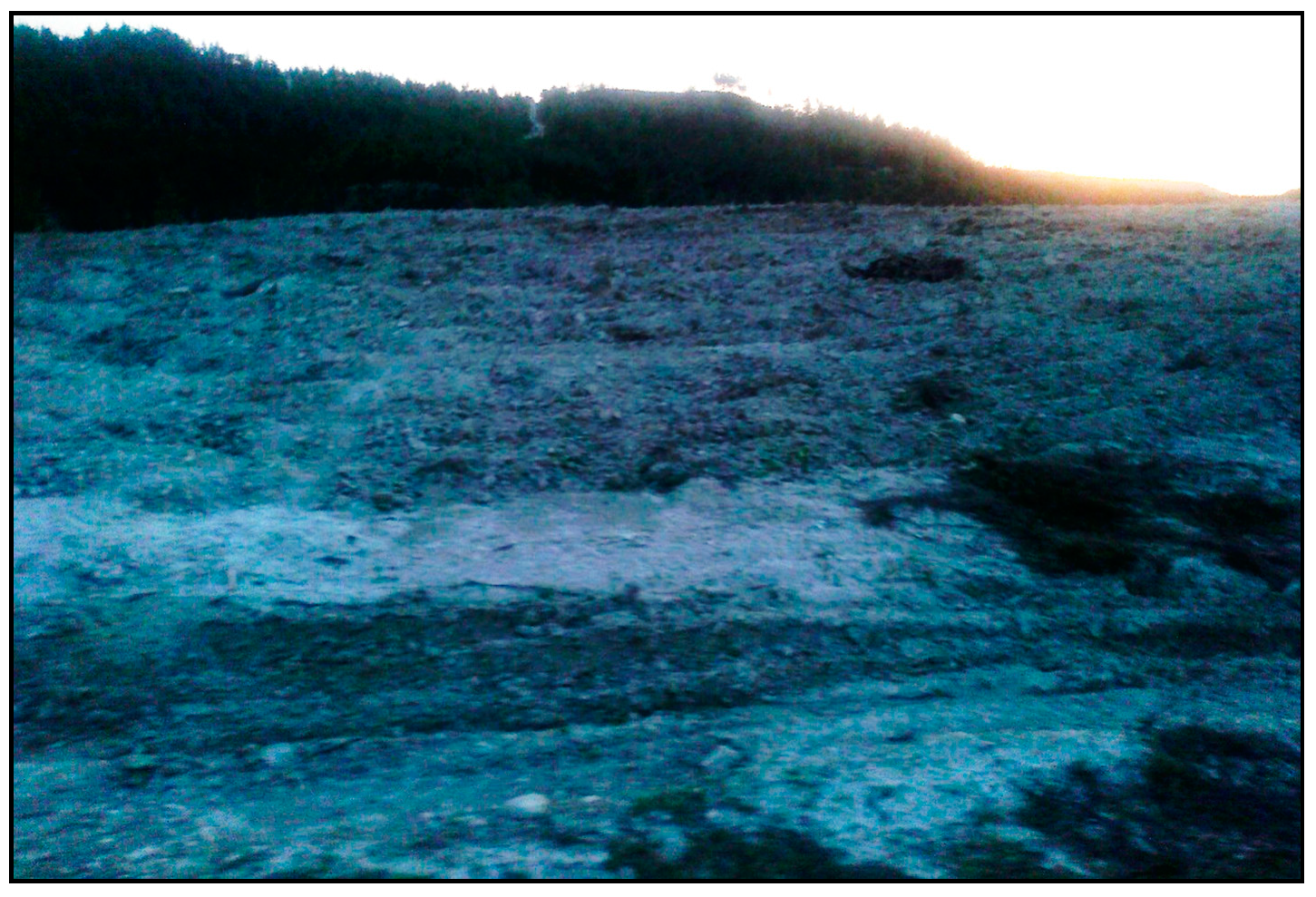


| Erosion Classes (t ha−1 year−1) | 2009/2010 | 2013/2014 | 2018/2019 | |||
|---|---|---|---|---|---|---|
| Area (km2) | Percent (%) | Area (km2) | Percent (%) | Area (km2) | Percent (%) | |
| Very low—VL (0–0.5) | 74.5 | 8.8 | 42.3 | 5.0 | 186.6 | 22.1 |
| Low—L (0.5–1) | 95.9 | 11.4 | 36.2 | 4.3 | 178.7 | 21.2 |
| Low medium—LM (1–2) | 198.8 | 23.5 | 84.1 | 9.9 | 217.1 | 25.7 |
| Medium—M (2–5) | 316.5 | 37.5 | 238.1 | 28.2 | 191 | 22.6 |
| High Medium—HM (5–10) | 113.5 | 13.4 | 252.7 | 29.9 | 52.3 | 6.2 |
| High—H (10–20) | 31.6 | 3.7 | 126.2 | 14.9 | 13.5 | 1.6 |
| Very high—VH (20–50) | 12.9 | 1.5 | 54.8 | 6.5 | 5.1 | 0.6 |
| Extremely high—EH (>50) | 1.4 | 0.2 | 10.8 | 1.3 | 0.7 | 0.1 |
| Soil Erosion Classes | Soil Erosion Classes 2013/2014 | Grand Total | ||||||||
|---|---|---|---|---|---|---|---|---|---|---|
| VL | L | LM | M | HM | H | VH | EH | |||
| Soil erosion classes 2009/2010 | VL | 4.23 | 1.80 | 1.25 | 1.03 | 0.36 | 0.08 | 0.04 | 0.02 | 8.81 |
| L | 0.47 | 1.77 | 3.65 | 3.25 | 1.63 | 0.44 | 0.12 | 0.03 | 11.35 | |
| LM | 0.19 | 0.57 | 4.02 | 10.73 | 5.33 | 2.05 | 0.55 | 0.07 | 23.52 | |
| M | 0.08 | 0.12 | 0.89 | 11.95 | 16.87 | 5.63 | 1.73 | 0.19 | 37.45 | |
| HM | 0.02 | 0.02 | 0.10 | 0.91 | 5.02 | 5.46 | 1.68 | 0.23 | 13.43 | |
| H | 0.01 | 0.01 | 0.02 | 0.21 | 0.50 | 1.07 | 1.69 | 0.23 | 3.74 | |
| VH | 0.01 | 0.00 | 0.01 | 0.06 | 0.16 | 0.19 | 0.65 | 0.43 | 1.53 | |
| EH | 0.01 | 0.00 | 0.00 | 0.02 | 0.02 | 0.02 | 0.02 | 0.08 | 0.17 | |
| Grand total | 5.02 | 4.30 | 9.94 | 28.17 | 29.89 | 14.93 | 6.48 | 1.28 | 100.00 | |
| Soil Erosion Classes | Soil Erosion Classes 2018/2019 | Grand Total | ||||||||
|---|---|---|---|---|---|---|---|---|---|---|
| VL | L | LM | M | HM | H | VH | EH | |||
| Soil erosion classes 2013/2014 | VL | 4.97 | 0.05 | 0.00 | 0.00 | 0.00 | 0.00 | 0.00 | 0.00 | 5.02 |
| L | 3.71 | 0.54 | 0.04 | 0.00 | 0.00 | 0.00 | 0.00 | 0.00 | 4.30 | |
| LM | 5.34 | 3.69 | 0.87 | 0.06 | 0.00 | 0.00 | 0.00 | 0.00 | 9.95 | |
| M | 5.94 | 10.08 | 9.55 | 2.48 | 0.10 | 0.01 | 0.00 | 0.00 | 28.16 | |
| HM | 1.87 | 5.59 | 11.17 | 10.32 | 0.84 | 0.09 | 0.00 | 0.00 | 29.89 | |
| H | 0.23 | 1.02 | 3.40 | 7.28 | 2.76 | 0.21 | 0.03 | 0.00 | 14.93 | |
| VH | 0.02 | 0.18 | 0.65 | 2.31 | 2.17 | 0.93 | 0.20 | 0.01 | 6.47 | |
| EH | 0.00 | 0.00 | 0.02 | 0.14 | 0.32 | 0.36 | 0.37 | 0.07 | 1.28 | |
| Grand total | 22.08 | 21.15 | 25.70 | 22.60 | 6.19 | 1.60 | 0.60 | 0.08 | 100.00 | |
| Soil Erosion Classes | Soil Erosion Classes 2018/2019 | Grand Total | ||||||||
|---|---|---|---|---|---|---|---|---|---|---|
| VL | L | LM | M | HM | H | VH | EH | |||
| Soil erosion classes 2009/2010 | VL | 7.22 | 0.95 | 0.42 | 0.16 | 0.03 | 0.01 | 0.01 | 0.00 | 8.81 |
| L | 5.76 | 3.10 | 1.56 | 0.75 | 0.12 | 0.04 | 0.01 | 0.00 | 11.35 | |
| LM | 6.03 | 7.93 | 6.06 | 2.83 | 0.49 | 0.13 | 0.04 | 0.01 | 23.52 | |
| M | 2.65 | 8.13 | 14.23 | 10.56 | 1.52 | 0.27 | 0.08 | 0.02 | 37.45 | |
| HM | 0.28 | 0.82 | 2.89 | 6.75 | 2.28 | 0.30 | 0.09 | 0.01 | 13.43 | |
| H | 0.08 | 0.16 | 0.41 | 1.22 | 1.32 | 0.44 | 0.09 | 0.01 | 3.74 | |
| VH | 0.04 | 0.05 | 0.11 | 0.30 | 0.40 | 0.38 | 0.24 | 0.01 | 1.52 | |
| EH | 0.02 | 0.01 | 0.01 | 0.03 | 0.02 | 0.02 | 0.05 | 0.02 | 0.17 | |
| Grand total | 22.08 | 21.15 | 25.70 | 22.60 | 6.19 | 1.60 | 0.60 | 0.08 | 100.00 | |
Publisher’s Note: MDPI stays neutral with regard to jurisdictional claims in published maps and institutional affiliations. |
© 2020 by the author. Licensee MDPI, Basel, Switzerland. This article is an open access article distributed under the terms and conditions of the Creative Commons Attribution (CC BY) license (http://creativecommons.org/licenses/by/4.0/).
Share and Cite
Almohamad, H. Impact of Land Cover Change Due to Armed Conflicts on Soil Erosion in the Basin of the Northern Al-Kabeer River in Syria Using the RUSLE Model. Water 2020, 12, 3323. https://doi.org/10.3390/w12123323
Almohamad H. Impact of Land Cover Change Due to Armed Conflicts on Soil Erosion in the Basin of the Northern Al-Kabeer River in Syria Using the RUSLE Model. Water. 2020; 12(12):3323. https://doi.org/10.3390/w12123323
Chicago/Turabian StyleAlmohamad, Hussein. 2020. "Impact of Land Cover Change Due to Armed Conflicts on Soil Erosion in the Basin of the Northern Al-Kabeer River in Syria Using the RUSLE Model" Water 12, no. 12: 3323. https://doi.org/10.3390/w12123323
APA StyleAlmohamad, H. (2020). Impact of Land Cover Change Due to Armed Conflicts on Soil Erosion in the Basin of the Northern Al-Kabeer River in Syria Using the RUSLE Model. Water, 12(12), 3323. https://doi.org/10.3390/w12123323





